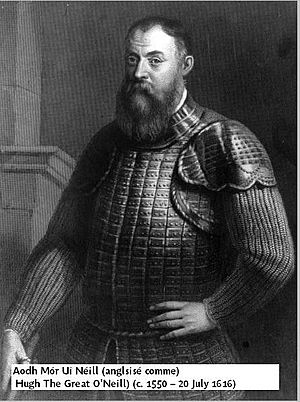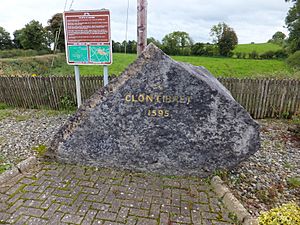Battle of Clontibret facts for kids
Quick facts for kids Battle of Clontibret |
|||||||
|---|---|---|---|---|---|---|---|
| Part of the Nine Years' War | |||||||
 Aodh_Uî_Neill (born in Dungannon 1550-1616 died in Rome) Earl of Tyrone |
|||||||
|
|||||||
| Belligerents | |||||||
| Commanders and leaders | |||||||
| Sir Henry Bagenal | Earl of Tyrone | ||||||
| Strength | |||||||
| 1,750 | 4,000 | ||||||
| Casualties and losses | |||||||
| 300-700 killed, more wounded | low | ||||||
The Battle of Clontibret was a big fight in County Monaghan, Ireland. It happened in May 1595 during the Nine Years' War.
An English army of 1,750 soldiers, led by Henry Bagenal, was ambushed. A larger Irish army, led by Hugh O'Neill, Earl of Tyrone, attacked them near Clontibret.
The English soldiers were on their way to help their friends stuck in Monaghan Castle. The English army lost many soldiers. But a brave charge by their cavalry (soldiers on horseback) saved them from being completely defeated.
The Irish winning this battle surprised the English. It was their first major loss in the war.
Contents
Why the Battle Happened
The Start of the Nine Years' War
The Nine Years' War began because Irish lords in Ulster felt their traditional rights were being taken away. The English government was trying to control more of Ireland.
For example, the English broke up the MacMahon family's power in Monaghan. They also let English lords get rich at the expense of Irish lords. English soldiers also moved into Hugh Maguire's land in Fermanagh.
All these actions made the Irish leaders believe their lands and way of life were in danger.
Tyrone's Actions
Hugh O'Neill of Tyrone fought the English indirectly at first. From 1593 to early 1595, he used other Irish leaders like Hugh Maguire and Hugh Roe O'Donnell to fight. This gave him time to make his own army stronger in Ulster.
But in February 1595, Tyrone openly declared war. He attacked and captured the Blackwater Fort. This fort was on the border of Counties Tyrone and Armagh.
The English Response
After taking the fort, O'Neill quickly surrounded the English soldiers at Monaghan Castle. Sir Henry Bagenal, who was the commander of the English forces, marched to help them.
He left Dundalk on May 25 (or June 4 by the new calendar) and went through Newry. His army had 1,750 soldiers. Some were experienced fighters, but many were new recruits. Most of Bagenal's men were foot soldiers with muskets and pikes. He also had a small group of horsemen.
The English leaders in Dublin did not think Tyrone's army was a big threat. Some thought the English army didn't have enough gunpowder. But they were told not to worry.
The Battle of Clontibret
First Day: The Ambush at Crossdall
The Battle of Clontibret was really a fight that lasted two days. Bagenal's army was attacked on its way to and from Monaghan Castle.
On May 25, as they marched to Monaghan, the English were ambushed. This happened at Crossdall, about 4 miles (6.5 km) from the town. It was a very difficult place for the English army.
Tyrone sent 700-800 Irish soldiers with muskets and calivers (types of guns). They were supported by more Irish fighters. Captain Richard Cuney led 150 English soldiers to hold back the Irish. This allowed the rest of the English army to pass.
Cuney's group fought for about four hours. Then they rejoined the main army as it moved towards Monaghan. This first fight cost the English 12 killed and 30 wounded.
As Bagenal's army got close to Monaghan, the Irish soldiers surrounding the town left. The English soldiers inside the castle got new supplies and more men. Bagenal was worried about his gunpowder. He had used a lot of it already.
Second Day: The Main Ambush
The next day, May 27, Bagenal started back towards Newry. He took a different route through Clontibret. This area had many hills, bogs (wetlands), and woods. It was a perfect place for an ambush. Bagenal said he took this route to protect women and children with the army.
Tyrone placed his soldiers on both sides of the English path. Luckily for Bagenal, Tyrone couldn't use all his soldiers. This was because Sir George Bingham had attacked Tyrconnell by sea. This made Tyrone's friend, Hugh Roe O'Donnell, leave to defend his home.
Tyrone's army had about 4,000 fighters. They included soldiers from the O'Neills, MacMahons, and Maguires families. There were also Scottish mercenaries (paid soldiers). The Irish also had many more cavalry and gunmen than before. The gunmen even wore red coats and fought very well.
Bagenal divided his men into three groups. Each group had pikemen (soldiers with long spears) and gunmen. Tyrone sent his brother, Cormac MacBaron, to take high ground. He also put gunmen in a bog. Tyrone planned to attack the back of the English army.
Fierce Fighting
The English army came under fire right away. Then they walked into a big ambush near the church at Clontibret. The Irish attacked from the front, sides, and back. Their gunmen, supported by horsemen and pikemen, fired at the English from close range.
The English army stopped moving. For over three hours, they only moved a quarter-mile. The Irish soldiers worked together very well. They would fire their guns, then retreat to reload, and then come back to fire again.
The English soldiers started to run out of gunpowder. Their pikemen had to charge forward to push the Irish back. But when the English pikemen returned to their group, the Irish gunmen moved forward again.
Bagenal's situation became very bad. Tyrone moved in, hoping one last attack would break the English. But just as Tyrone seemed about to win, the English cavalry made a brave charge.
Cornet Sedgreve led forty horsemen straight at Tyrone. Both Tyrone and Sedgreve were knocked off their horses. Sedgreve grabbed Tyrone by the neck. But Tyrone was wearing strong armor, which had been given to him by an English leader. One of Tyrone's officers hurt Sedgreve's arm. Then Tyrone wounded Sedgreve.
The English cavalry suffered many losses. But Sedgreve's brave act gave Bagenal's army time to start moving again. The Irish had blocked all the paths through the bog. But slowly, the English pushed forward.
The experienced English soldiers fought well. But many of Bagenal's men were new to fighting. The fierce battle also made Tyrone's army run out of gunpowder.
The English army moved very slowly. As night came, Bagenal stopped his men and camped on a hilltop. Many soldiers seemed to be missing. There was fear the Irish would attack again in the dark. But no more attacks came. Soon after dawn, more English soldiers arrived from Newry to help them.
What Happened Next
Casualties and Shock
After the battle, it was learned that Hugh O'Neill couldn't follow up his attack because he ran out of gunpowder. This was ironic, as Bagenal also had very little gunpowder.
The English government was worried. They tried to hide the true number of English soldiers killed or wounded. This made people believe the rumors that the English had suffered a severe defeat. Many people believed the higher numbers reported by the Irish side.
The defeat shocked the English in Dublin. They were especially surprised by how modern and disciplined O'Neill's army was. Lord Deputy Russell wrote that the Irish had "great force of pikes and muskets, but also many trained and experienced leaders."
One experienced English officer said that the northern Irish rebels were much stronger now. They had more soldiers, better weapons, and more ammunition. He noted that 1,700 of the best English foot soldiers and nearly 300 horsemen were at Newry. But they were afraid to march the eight miles to Dundalk. They had to be sent by water. This had never happened before in Ireland.
Sir Ralph Lane, an English official, told Queen Elizabeth's secretary that "more men were hurt and killed in that late service than was convenient to declare."
The number of soldiers killed or wounded varies in different reports. Bagenal said only 31 English were killed and 109 wounded on the second day. But his losses were almost certainly higher. Irish reports claimed up to 700 English soldiers were killed. Estimates for Irish losses range from 100 to 400 killed.
Three years later, Bagenal led another army into an ambush by Tyrone. This was at the Battle of the Yellow Ford. The English general was killed, and his troops were completely defeated with many losses.


